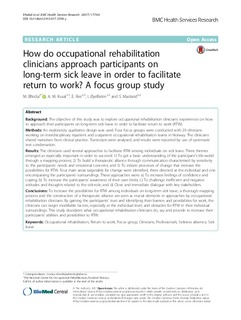| dc.contributor.author | Eftedal, Monica | |
| dc.contributor.author | Kvaal, Astrid Marie | |
| dc.contributor.author | Ree, Eline | |
| dc.contributor.author | Øyeflaten, Irene Larsen | |
| dc.contributor.author | Mæland, Silje | |
| dc.coverage.spatial | Norway | nb_NO |
| dc.date.accessioned | 2018-01-12T09:53:42Z | |
| dc.date.available | 2018-01-12T09:53:42Z | |
| dc.date.created | 2017-09-21T14:35:31Z | |
| dc.date.issued | 2017-11 | |
| dc.identifier.citation | Eftedal, M. (et al.) How do occupational rehabilitation clinicians approach participants on long-term sick leave in order to facilitate return to work? - A focus-group study. BMC Health Services Research. 2017, 17(744) | nb_NO |
| dc.identifier.issn | 1472-6963 | |
| dc.identifier.uri | http://hdl.handle.net/11250/2477142 | |
| dc.description.abstract | Background
The objective of this study was to explore occupational rehabilitation clinicians’ experiences on how to approach their participants on long-term sick leave in order to facilitate return to work (RTW).
Methods
An exploratory qualitative design was used. Four focus groups were conducted with 29 clinicians working on interdisciplinary inpatient and outpatient occupational rehabilitation teams in Norway. The clinicians shared narratives from clinical practice. Transcripts were analysed, and results were reported by use of systematic text condensation.
Results
The clinicians used several approaches to facilitate RTW among individuals on sick leave. Three themes emerged as especially important in order to succeed: 1) To get a basic understanding of the participant’s life-world through a mapping process; 2) To build a therapeutic alliance through communication characterised by sensitivity to the participants’ needs and emotional concerns; and 3) To initiate processes of change that increase the possibilities for RTW. Four main areas targetable for change were identified, three directed at the individual and one encompassing the participants’ surroundings. These approaches were: a) To increase feelings of confidence and coping; b) To increase the participants’ awareness of their own limits; c) To challenge inefficient and negative attitudes and thoughts related to the sick-role; and d) Close and immediate dialogue with key stakeholders.
Conclusions
To increase the possibilities for RTW among individuals on long-term sick leave, a thorough mapping process and the construction of a therapeutic alliance are seen as crucial elements in approaches by occupational rehabilitation clinicians. By gaining the participants’ trust and identifying their barriers and possibilities for work, the clinicians can target modifiable factors, especially at the individual level, and obstacles for RTW in their individual surroundings. This study elucidates what occupational rehabilitation clinicians do, say and provide to increase their participants’ abilities and possibilities to RTW. | nb_NO |
| dc.language.iso | eng | nb_NO |
| dc.publisher | BioMed Central | nb_NO |
| dc.rights | Navngivelse 4.0 Internasjonal | * |
| dc.rights.uri | http://creativecommons.org/licenses/by/4.0/deed.no | * |
| dc.subject | helse- og sosialfag | nb_NO |
| dc.subject | sykemeldinger | nb_NO |
| dc.subject | langtidssykemeldte | nb_NO |
| dc.subject | fokusgruppe | nb_NO |
| dc.title | How do occupational rehabilitation clinicians approach participants on long-term sick leave in order to facilitate return to work? - A focus-group study | nb_NO |
| dc.type | Journal article | nb_NO |
| dc.type | Peer reviewed | nb_NO |
| dc.description.version | publishedVersion | nb_NO |
| dc.rights.holder | © The Author(s) 2017 | nb_NO |
| dc.subject.nsi | VDP::Medisinske Fag: 700::Helsefag: 800 | nb_NO |
| dc.source.pagenumber | 13 | nb_NO |
| dc.source.volume | 17 | nb_NO |
| dc.source.journal | BMC Health Services Research | nb_NO |
| dc.source.issue | 744 | nb_NO |
| dc.identifier.doi | 10.1186/s12913-017-2709-y | |
| dc.identifier.cristin | 1496563 | |
| cristin.unitcode | 217,13,0,0 | |
| cristin.unitname | Det helsevitenskapelige fakultet | |
| cristin.ispublished | true | |
| cristin.fulltext | original | |
| cristin.qualitycode | 2 | |

